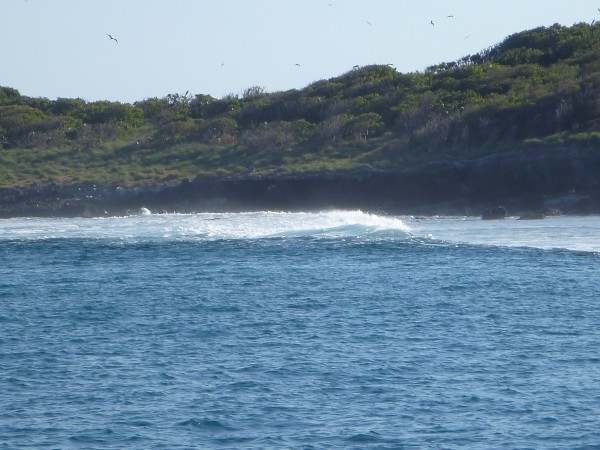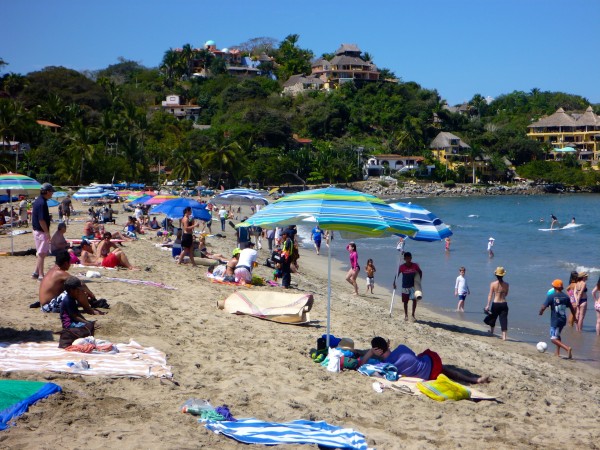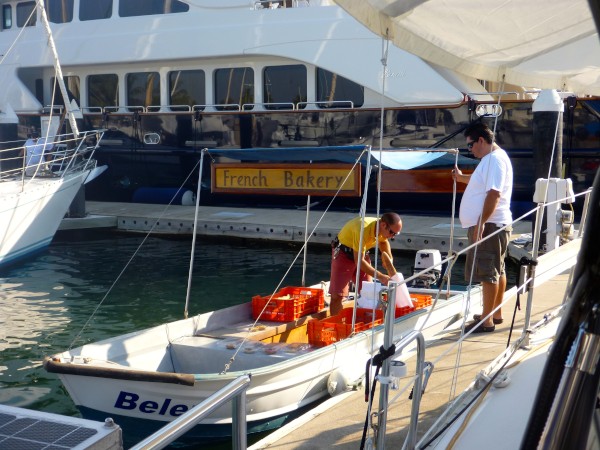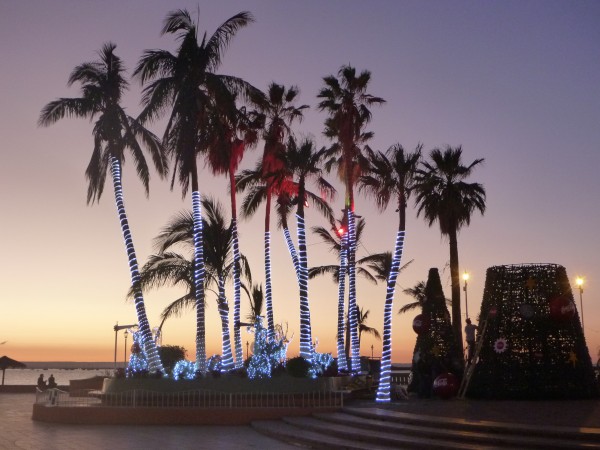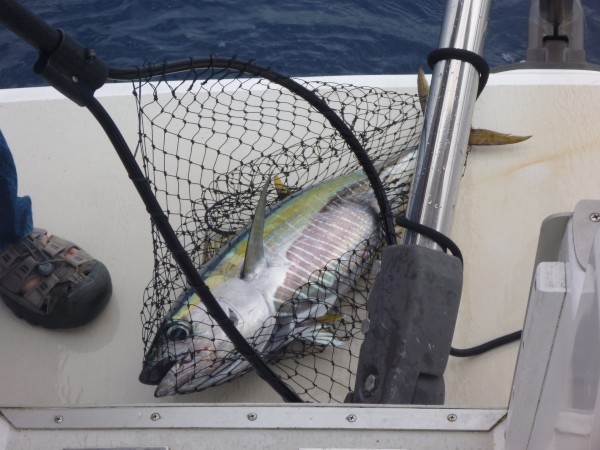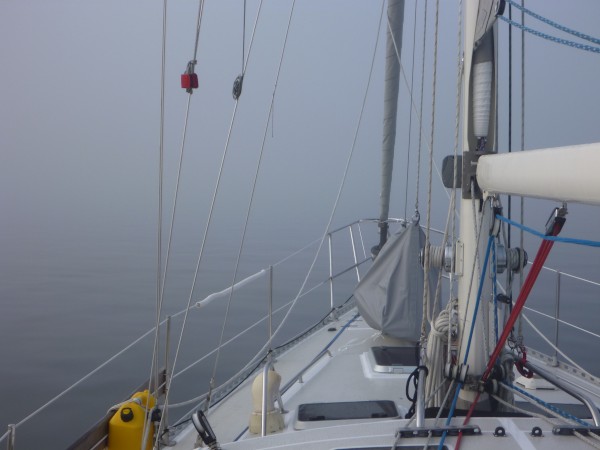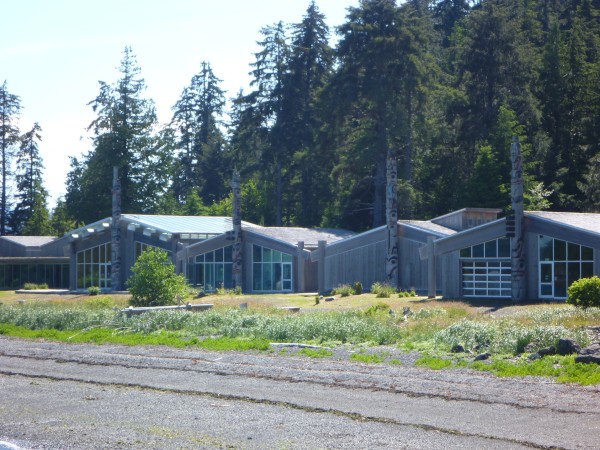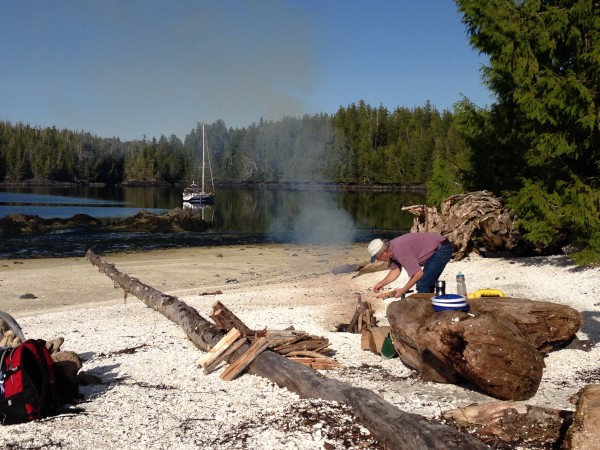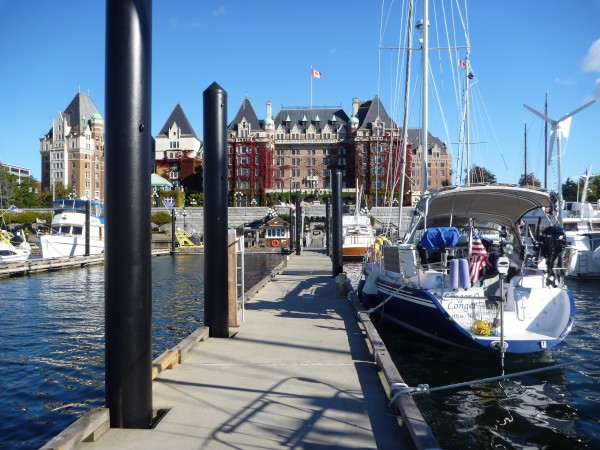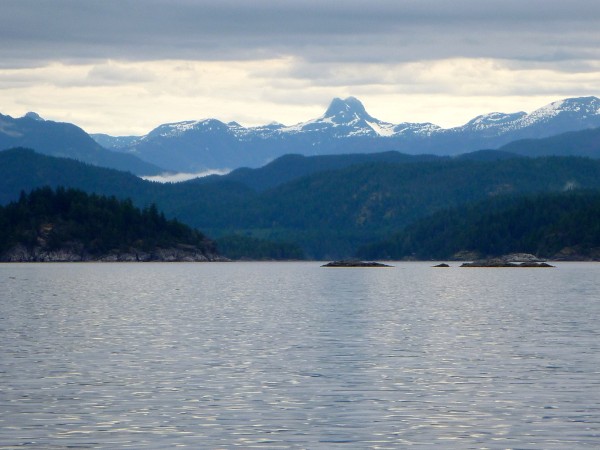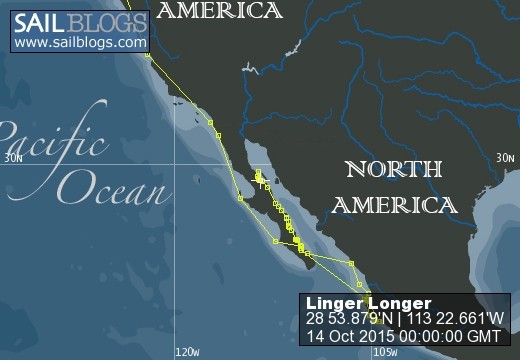
Linger Longer
14 September 2016
06 August 2016
09 July 2016
19 March 2016
19 December 2015
18 December 2015
18 December 2015
03 November 2015
18 July 2015
24 May 2015
04 April 2015
31 March 2015
26 February 2015
15 February 2015 | Barra de Navidad
07 February 2015 | Tenacatita Bay
04 February 2015
26 January 2015 | 19 18.051'N
04 January 2015 | La Cruz, Nayarit, Mexico
25 December 2014 | La Paz, Baja California Sur, Mexico
01 December 2014 | Ensenada, Mexico
Reflections by Kirk 8-27-13
01 September 2013
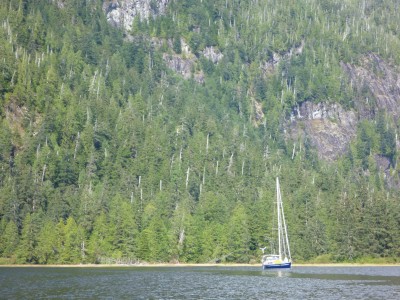
Reflections by Kirk 08-27-2013
Well here we are again, hunkered down waiting for more gale force winds from the southeast to pass by. I'll try to describe some of the sights, sounds and feelings of the past few weeks of dealing with this very unseasonable weather pattern. It all started maybe three weeks ago. You know how sometimes the passage of time seems different. Sometimes an event, days, months or years ago seems as though it happened yesterday, and sometimes other events seem to have occurred much longer ago than the clock or calendar would dictate. In our case, three weeks seems like a very long time ago. On the evening of the day that we saw all of the whales off the northwest side of Brooks Peninsula, we were anchored in a really nice place called Columbia Cove at the southwest side of the same peninsula. We had been to this same cove on our previous trip in 2011 and had great memories of it. It had been a warm sunny day, one of those take a shower and air dry in the cockpit while watching the shapes of innumerable islets and rocks silhouetted by the setting sun kind of days. So we looked forward to spending some more time there. But the weather forecast changed that for us. Southerly winds that would blow up to twenty-five knots would funnel right into our cozy little cove and make for a terribly uncomfortable time there. We moved a short distance, ten or twelve miles to the Bunsby Islands, a really beautiful group of very small tree covered islands that could provide shelter from southerly winds.
The Bunsbys are really special. From almost anywhere you anchor, crashing waves can be either seen or heard. There are many different pocket beaches inside the protection of the islands that make for a kayakers paradise. We looked forward to maybe a few days of pleasant kayak exploration and beach fires with new friends from other boats. But once again the weather forecast foiled us. Gale force winds were expected within the next thirty-six hours and the anchorages here just did not feel secure enough for that so off we go to find a "bombproof" anchorage before its too late. Again, not very far, maybe 15 miles to Dixie Cove, three miles or so into Kyuquot Sound (Ky you' cut). A lot of place names up here begin with a K or Qu. It must be a means of trying to make English spelling for native words. On the way to Dixie, we forlornly listened to forecasts of gale force winds from the southeast for at least the next three days. We knew that once back into protected areas of Kyuquot Sound, VHF radio reception would be nil.
Dixie was cool. We watched "George" the sea otter quite a bit, caught a very nice rockfish, and finished off a bottle of fifteen-year-old scotch with guys on one of the other boats in the same predicament. On the morning of the third day, we went out toward the entrance of the Sound to get a VHF weather forecast and to see actual conditions. Conditions were ugly and we turned back to try out another anchorage advertised as almost equally bombproof as Dixie Cove. But first we took the time to check out a place that we had really wanted to spend a night at called Rugged Cove.
Rugged Cove is a very beautiful rock bound cove right at the entrance to the Sound that is positioned so as to offer some protection from the southeast gales. There are two wide sandy beaches and a short trail through the trees to the ocean side where we may be able to watch the full fury of the gales and walk amongst piles of bleached driftwood logs. Alas, ocean swell wrapped around the corner of and into the cove. This would make for a bit of an uncomfortable time as the boat would rock and roll every few seconds as the swells passed under. If we ever get back out here, this place will be high on our list if the weather is a little more settled.
While on the way to a new place a few miles into the Sound, unnamed on the charts, but described as another secure anchorage in our guidebook, we caught a nice salmon. Upon negotiating yet another narrow winding entry, we round the last bend to find the other two boats we have been traveling with lying serenely at anchor. Keep in mind that for the past several days the sky has been continually overcast with frequent periods of rain, sometimes heavy. Not especially good for the spirits. So the sight of kindred souls with the potential for getting together to tell stories, discuss strategies, and swap lies filled with laughter was unusually uplifting. Once again, the center of social activity was a beautiful and well-outfitted Halberg Rassey 46 occupied by mom, dad and their delightful artistic young daughter. While we are dependent on VHF radio for weather, they have a sat phone setup for weather so we got the latest forecast and decided to take another trip to check conditions early in the morning. Shortly after sunrise, we left about twenty minutes behind the Halberg Rassey. As we approached the entrance to the Sound the wind picked up and we saw lots of whitecaps in the distance. Just about the time the first strong gust hit us we saw the Halberg Rassey heading back toward us bouncing wildly in the wind driven waves. We turned around and headed back to Dixie Cove where I prepared delicious chowder from leftover salmon.
The following day we finally rounded the next point and entered Espranaza Inlet and a day later landed at the tiny town of Tahsis, the first time we touched a dock since Port McNeill over two weeks prior. Tahsis was really fine for multiple reasons. It had been two years earlier, nearly to the day, when from the exact same phone booth (no cell coverage way out here) I found out that my brother had received a work related phone call on a Friday and by Tuesday was on a plane to Trinidad where he still works. The marina in Tahsis caters primarily to sport fishing folks, but still has room for maybe ten or twelve larger cruising boats. It is well kept with excellent, very helpful staff and just has a nice feel about the place. It was good to dump the accumulated trash, do laundry and shower with unlimited hot water. We heard stories from several locals of bear and cougar in the immediate area. No one made a particularly big deal about it as this has been a common occurrence forever and they just adjust to the local wildlife.
After a nearly steady diet of seafood, the prospect of barbecued ribs on the patio deck was more temptation than I could stand. The meal was fabulous and the entertainment was mesmerizing. There were six fish cleaning stations adjacent to the patio and all were continually in use with people queued up to use the next one available. These guys had dock carts full of salmon, halibut, lingcod and various types of rockfish. There was a photo-op station with a scale and six hooks where the biggest fish from each boat was hung for the photographs. Over the course of two hours, we watched as hundreds of fish were cleaned. It was interesting to watch as many of the men would have a variety of fillet knives and select just the right one for the type of fish and then carefully sharpen the knife before going to work. We saw 75-pound halibut, 40-pound salmon and lingcod and many very large rockfish in an array of dazzling colors.
The first ten or so miles of the trip from Tahsis back towards the ocean is quite stunning. The passage is maybe a half-mile wide and framed on both sides by tree-clad mountains right down to waters edge. Once beyond this fjord like area, the mouth of Nootka Sound opens up with several islands in its mouth. We spent two nights in different beautiful places waiting for a weather window to round Estevan Point, the second major projection of land out into the Pacific on the west side of Vancouver Island. Like Brooks Peninsula, shallows surrounding Estevan Point make for confused seas and food for Humpbacks. We saw lots of "blows" in the distance and fortunately, they remained in the distance. The confused and lumpy seas did create a problem for us as some sediment in the fuel tank got sloshed around and plugged our fuel filter bringing the motor to a sudden stop. We got the filter situation resolved in short order, but decided to raise sails instead of motoring. Good choice. We had a wonderful sail of several hours out in the ocean with only one jibe before entering Hot Springs Cove. As the name implies there is indeed a wonderful hot spring near waters edge that spills through the rocks into a few small pools before finding its way down to the salt water. The small peninsula where the hot springs are located was donated to the BC Province several decades ago and is a well-maintained facility. There is a nice dock with several small buildings at its head. From there, a boardwalk leads about a mile to the springs where a nice covered area with changing rooms awaits. The boardwalk is made of three-foot long two-by-eight planks fastened to support beams beneath. It has been a practice for many years that visiting boats carve boat names and years of visitations on the planks. We added '13 to the plank that we had carved two years ago. Bathing au natural is strongly discouraged due to the immense popularity. The smell of sulpher wafts throughout the area surrounding the spring. The downside to this wonderful place is its popularity and proximity to populated areas. Water taxis and floatplanes from Tofino come and go all day long disgorging way too many people for the few small pools to accommodate. For visiting boaters and campers, early morning and evenings provide the times when you have a chance to find a spot to soak in the hot water. Kris and I were up in the springs at about 0700 and had the place all to ourselves for about an hour before we heard the sounds of the first water taxi roaring into the cove.
Since then we have worked our way further south via inland passages to Clayquot Sound and have enjoyed a few more excellent anchorages of which two demand further discussion. The first was Bacchante Bay. This bay is about one mile long by one-half mile wide and surrounded by tall tree-covered mountains with several peaks over three thousand feet and at least one over four thousand feet. One area has a large expanse of bare granite vertical walls. We could hear what sounded like a large trickle of water coming from somewhere high above us. Just a stunning place. The head of the bay has a creek that makes for excellent kayak exploration.
The day was sunny and nice so we made a decision to spend another day to explore a little up the creek and maybe take the opportunity for some fresh water bathing. By mid morning the next day, the clouds started to roll in and a few hours later very strong winds attacked us from the mouth of the bay. After an hour or so, the wind slowed down and very heavy rain pounded down. We ventured out of the cabin periodically and discovered that what sounded like a large trickle of water had turned into a spectacular waterfall that we could now see through the trees for a height of maybe one hundred feet. The other interesting thing about Bacchante Bay was our first experience with downslope winds. Normally, winds come from either the head or mouth of a narrow bay like this one and never, for us, from the direction of a three thousand foot mountain on the side. But at dusk we started to experience furious gusts from wind coming straight down off of the side of the mountain. I guess that as rising heat during the day stops rising, the cold air on top of the mountain just comes barreling down the mountainside. We had heard of this but it was our first experience.
The other place worth mentioning is Ahousat, a place consisting of a large dock, a small general store and a small café. Three things make it particularly interesting. First, the owner who bought the place in the late fifties is the son of the man who donated the hot springs area to the BC government. The second thing is the local the people. This is the kind of place where everyone is friendly and will just sit around and talk. Older fisherman and the owner will sit on the bench in front of the general store for hours talking amongst themselves and ANYONE else who comes along. As I was talking to these gentlemen about local lore, weather conditions, and wildlife, everyone going into the store stopped to talk with them with the occasional youngster sitting on someone's knee and just jabbering away. I kept thinking of old TV shows depicting people sitting and talking around the old cracker barrel or a warm pot bellied stove. This may have been the friendliest place I have ever been to. The third thing is the wildlife. A family of wolves with a huge alpha male is known to live in the area and is frequently seen. Black bears are common neighbors. Cougars also frequent the area. The owner has shot three of them over the years and one of the heads is mounted on a wall in the store. The really good story involves the most recent sighting. It occurred during the day when something was sighted swimming across the inlet towards the dock. Everyone watching thought it was the big male wolf until it leapt out of the water onto the dock and started loping up the ramp. We heard this story from several people who were there and they all said this was the biggest cougar any had ever seen. The entire episode was captured on the store's video surveillance cameras. The video was sent to a Vancouver TV station and was aired a few days before we arrived. We watched the video on someone's computer as the crowd around all chimed in with their own version of what they had seen. We watched as a man shaking a round life buoy at the cat caused him to turn around and head back down the ramp. The big cat then loped down the dock toward another man who quickly retreated up another ramp to grab a broom and convinced the cat to turn around again. The cougar finally went up the first ramp and disappeared into the woods after the first guy stashed himself inside a doorway. We decided not to take a recommended hike to the beach that started behind the store.
And here we sit again in pouring rain waiting for the winds to allow us back into the ocean to push on southeast to Ucluelet and Barkley Sound. It has been raining hard and continuously for the past thirty-six hours, at least four inches of rain. We are nearing the end of this segment of our journey. Our plans for the winter are still unresolved, but we will definitely spend next summer up here again.
Let's just see what's around the next bend.
Well here we are again, hunkered down waiting for more gale force winds from the southeast to pass by. I'll try to describe some of the sights, sounds and feelings of the past few weeks of dealing with this very unseasonable weather pattern. It all started maybe three weeks ago. You know how sometimes the passage of time seems different. Sometimes an event, days, months or years ago seems as though it happened yesterday, and sometimes other events seem to have occurred much longer ago than the clock or calendar would dictate. In our case, three weeks seems like a very long time ago. On the evening of the day that we saw all of the whales off the northwest side of Brooks Peninsula, we were anchored in a really nice place called Columbia Cove at the southwest side of the same peninsula. We had been to this same cove on our previous trip in 2011 and had great memories of it. It had been a warm sunny day, one of those take a shower and air dry in the cockpit while watching the shapes of innumerable islets and rocks silhouetted by the setting sun kind of days. So we looked forward to spending some more time there. But the weather forecast changed that for us. Southerly winds that would blow up to twenty-five knots would funnel right into our cozy little cove and make for a terribly uncomfortable time there. We moved a short distance, ten or twelve miles to the Bunsby Islands, a really beautiful group of very small tree covered islands that could provide shelter from southerly winds.
The Bunsbys are really special. From almost anywhere you anchor, crashing waves can be either seen or heard. There are many different pocket beaches inside the protection of the islands that make for a kayakers paradise. We looked forward to maybe a few days of pleasant kayak exploration and beach fires with new friends from other boats. But once again the weather forecast foiled us. Gale force winds were expected within the next thirty-six hours and the anchorages here just did not feel secure enough for that so off we go to find a "bombproof" anchorage before its too late. Again, not very far, maybe 15 miles to Dixie Cove, three miles or so into Kyuquot Sound (Ky you' cut). A lot of place names up here begin with a K or Qu. It must be a means of trying to make English spelling for native words. On the way to Dixie, we forlornly listened to forecasts of gale force winds from the southeast for at least the next three days. We knew that once back into protected areas of Kyuquot Sound, VHF radio reception would be nil.
Dixie was cool. We watched "George" the sea otter quite a bit, caught a very nice rockfish, and finished off a bottle of fifteen-year-old scotch with guys on one of the other boats in the same predicament. On the morning of the third day, we went out toward the entrance of the Sound to get a VHF weather forecast and to see actual conditions. Conditions were ugly and we turned back to try out another anchorage advertised as almost equally bombproof as Dixie Cove. But first we took the time to check out a place that we had really wanted to spend a night at called Rugged Cove.
Rugged Cove is a very beautiful rock bound cove right at the entrance to the Sound that is positioned so as to offer some protection from the southeast gales. There are two wide sandy beaches and a short trail through the trees to the ocean side where we may be able to watch the full fury of the gales and walk amongst piles of bleached driftwood logs. Alas, ocean swell wrapped around the corner of and into the cove. This would make for a bit of an uncomfortable time as the boat would rock and roll every few seconds as the swells passed under. If we ever get back out here, this place will be high on our list if the weather is a little more settled.
While on the way to a new place a few miles into the Sound, unnamed on the charts, but described as another secure anchorage in our guidebook, we caught a nice salmon. Upon negotiating yet another narrow winding entry, we round the last bend to find the other two boats we have been traveling with lying serenely at anchor. Keep in mind that for the past several days the sky has been continually overcast with frequent periods of rain, sometimes heavy. Not especially good for the spirits. So the sight of kindred souls with the potential for getting together to tell stories, discuss strategies, and swap lies filled with laughter was unusually uplifting. Once again, the center of social activity was a beautiful and well-outfitted Halberg Rassey 46 occupied by mom, dad and their delightful artistic young daughter. While we are dependent on VHF radio for weather, they have a sat phone setup for weather so we got the latest forecast and decided to take another trip to check conditions early in the morning. Shortly after sunrise, we left about twenty minutes behind the Halberg Rassey. As we approached the entrance to the Sound the wind picked up and we saw lots of whitecaps in the distance. Just about the time the first strong gust hit us we saw the Halberg Rassey heading back toward us bouncing wildly in the wind driven waves. We turned around and headed back to Dixie Cove where I prepared delicious chowder from leftover salmon.
The following day we finally rounded the next point and entered Espranaza Inlet and a day later landed at the tiny town of Tahsis, the first time we touched a dock since Port McNeill over two weeks prior. Tahsis was really fine for multiple reasons. It had been two years earlier, nearly to the day, when from the exact same phone booth (no cell coverage way out here) I found out that my brother had received a work related phone call on a Friday and by Tuesday was on a plane to Trinidad where he still works. The marina in Tahsis caters primarily to sport fishing folks, but still has room for maybe ten or twelve larger cruising boats. It is well kept with excellent, very helpful staff and just has a nice feel about the place. It was good to dump the accumulated trash, do laundry and shower with unlimited hot water. We heard stories from several locals of bear and cougar in the immediate area. No one made a particularly big deal about it as this has been a common occurrence forever and they just adjust to the local wildlife.
After a nearly steady diet of seafood, the prospect of barbecued ribs on the patio deck was more temptation than I could stand. The meal was fabulous and the entertainment was mesmerizing. There were six fish cleaning stations adjacent to the patio and all were continually in use with people queued up to use the next one available. These guys had dock carts full of salmon, halibut, lingcod and various types of rockfish. There was a photo-op station with a scale and six hooks where the biggest fish from each boat was hung for the photographs. Over the course of two hours, we watched as hundreds of fish were cleaned. It was interesting to watch as many of the men would have a variety of fillet knives and select just the right one for the type of fish and then carefully sharpen the knife before going to work. We saw 75-pound halibut, 40-pound salmon and lingcod and many very large rockfish in an array of dazzling colors.
The first ten or so miles of the trip from Tahsis back towards the ocean is quite stunning. The passage is maybe a half-mile wide and framed on both sides by tree-clad mountains right down to waters edge. Once beyond this fjord like area, the mouth of Nootka Sound opens up with several islands in its mouth. We spent two nights in different beautiful places waiting for a weather window to round Estevan Point, the second major projection of land out into the Pacific on the west side of Vancouver Island. Like Brooks Peninsula, shallows surrounding Estevan Point make for confused seas and food for Humpbacks. We saw lots of "blows" in the distance and fortunately, they remained in the distance. The confused and lumpy seas did create a problem for us as some sediment in the fuel tank got sloshed around and plugged our fuel filter bringing the motor to a sudden stop. We got the filter situation resolved in short order, but decided to raise sails instead of motoring. Good choice. We had a wonderful sail of several hours out in the ocean with only one jibe before entering Hot Springs Cove. As the name implies there is indeed a wonderful hot spring near waters edge that spills through the rocks into a few small pools before finding its way down to the salt water. The small peninsula where the hot springs are located was donated to the BC Province several decades ago and is a well-maintained facility. There is a nice dock with several small buildings at its head. From there, a boardwalk leads about a mile to the springs where a nice covered area with changing rooms awaits. The boardwalk is made of three-foot long two-by-eight planks fastened to support beams beneath. It has been a practice for many years that visiting boats carve boat names and years of visitations on the planks. We added '13 to the plank that we had carved two years ago. Bathing au natural is strongly discouraged due to the immense popularity. The smell of sulpher wafts throughout the area surrounding the spring. The downside to this wonderful place is its popularity and proximity to populated areas. Water taxis and floatplanes from Tofino come and go all day long disgorging way too many people for the few small pools to accommodate. For visiting boaters and campers, early morning and evenings provide the times when you have a chance to find a spot to soak in the hot water. Kris and I were up in the springs at about 0700 and had the place all to ourselves for about an hour before we heard the sounds of the first water taxi roaring into the cove.
Since then we have worked our way further south via inland passages to Clayquot Sound and have enjoyed a few more excellent anchorages of which two demand further discussion. The first was Bacchante Bay. This bay is about one mile long by one-half mile wide and surrounded by tall tree-covered mountains with several peaks over three thousand feet and at least one over four thousand feet. One area has a large expanse of bare granite vertical walls. We could hear what sounded like a large trickle of water coming from somewhere high above us. Just a stunning place. The head of the bay has a creek that makes for excellent kayak exploration.
The day was sunny and nice so we made a decision to spend another day to explore a little up the creek and maybe take the opportunity for some fresh water bathing. By mid morning the next day, the clouds started to roll in and a few hours later very strong winds attacked us from the mouth of the bay. After an hour or so, the wind slowed down and very heavy rain pounded down. We ventured out of the cabin periodically and discovered that what sounded like a large trickle of water had turned into a spectacular waterfall that we could now see through the trees for a height of maybe one hundred feet. The other interesting thing about Bacchante Bay was our first experience with downslope winds. Normally, winds come from either the head or mouth of a narrow bay like this one and never, for us, from the direction of a three thousand foot mountain on the side. But at dusk we started to experience furious gusts from wind coming straight down off of the side of the mountain. I guess that as rising heat during the day stops rising, the cold air on top of the mountain just comes barreling down the mountainside. We had heard of this but it was our first experience.
The other place worth mentioning is Ahousat, a place consisting of a large dock, a small general store and a small café. Three things make it particularly interesting. First, the owner who bought the place in the late fifties is the son of the man who donated the hot springs area to the BC government. The second thing is the local the people. This is the kind of place where everyone is friendly and will just sit around and talk. Older fisherman and the owner will sit on the bench in front of the general store for hours talking amongst themselves and ANYONE else who comes along. As I was talking to these gentlemen about local lore, weather conditions, and wildlife, everyone going into the store stopped to talk with them with the occasional youngster sitting on someone's knee and just jabbering away. I kept thinking of old TV shows depicting people sitting and talking around the old cracker barrel or a warm pot bellied stove. This may have been the friendliest place I have ever been to. The third thing is the wildlife. A family of wolves with a huge alpha male is known to live in the area and is frequently seen. Black bears are common neighbors. Cougars also frequent the area. The owner has shot three of them over the years and one of the heads is mounted on a wall in the store. The really good story involves the most recent sighting. It occurred during the day when something was sighted swimming across the inlet towards the dock. Everyone watching thought it was the big male wolf until it leapt out of the water onto the dock and started loping up the ramp. We heard this story from several people who were there and they all said this was the biggest cougar any had ever seen. The entire episode was captured on the store's video surveillance cameras. The video was sent to a Vancouver TV station and was aired a few days before we arrived. We watched the video on someone's computer as the crowd around all chimed in with their own version of what they had seen. We watched as a man shaking a round life buoy at the cat caused him to turn around and head back down the ramp. The big cat then loped down the dock toward another man who quickly retreated up another ramp to grab a broom and convinced the cat to turn around again. The cougar finally went up the first ramp and disappeared into the woods after the first guy stashed himself inside a doorway. We decided not to take a recommended hike to the beach that started behind the store.
And here we sit again in pouring rain waiting for the winds to allow us back into the ocean to push on southeast to Ucluelet and Barkley Sound. It has been raining hard and continuously for the past thirty-six hours, at least four inches of rain. We are nearing the end of this segment of our journey. Our plans for the winter are still unresolved, but we will definitely spend next summer up here again.
Let's just see what's around the next bend.
Comments
| Vessel Name: | S/V Linger Longer |
| Vessel Make/Model: | Sceptre 41/43 |
| Hailing Port: | Seattle, WA |
| Crew: | Kirk & Kristin Doyle |
| Extra: | |
| Home Page: | http://www.k2doyle.com |
S/V Linger Longer's Photos - Main
|
Heading north into the Sea of Cortez for the summer where there is less change of hurricanes.
72 Photos
Created 19 December 2015
|
Who: Kirk & Kristin Doyle
Port: Seattle, WA
